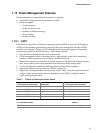
Product Description
21
✏
NOTE
The recommended method of accessing the date in systems with Intel desktop boards is indirectly
from the Real-Time Clock (RTC) via the BIOS. The BIOS on Intel desktop boards contains a
century checking and maintenance feature. This feature checks the two least significant digits of
the year stored in the RTC during each BIOS request (INT 1Ah) to read the date and, if less than
80 (i.e., 1980 is the first year supported by the PC), updates the century byte to 20. This feature
enables operating systems and applications using the BIOS date/time services to reliably
manipulate the year as a four-digit value.
For information about Refer to
Proper date access in systems with Intel desktop boards http://support.intel.com/support/year2000/
1.7 I/O Controller
The SMSC LPC47M102 I/O controller provides the following features:
• Low pin count (LPC) interface
• One serial port
• Infrared (IrDA) interface
• Intelligent power management, including a programmable wake up event interface
• Fan control:
One pulse width modulation (PWM) fan speed control output
One fan tachometer input
The BIOS Setup program provides configuration options for the I/O controller.
For information about Refer to
SMSC LPC47M102 I/O controller http://www.smsc.com
The IrDA interface Section 2.8.3, page 46
1.8 Serial Debug Port
The board has one 9-pin serial debug port connector. The serial debug port’s
NS16C550-compatible UART supports data transfers at rates of up to 115.2 kbits/sec with BIOS
support. The serial debug port can be assigned as COM1 (3F8h), COM2 (2F8h), COM3 (3E8h), or
COM4 (2E8h).
For information about Refer to
The location of the serial debug port connector Figure 5, page 41
The signal names of the serial debug port connector Table 26, page 43


















